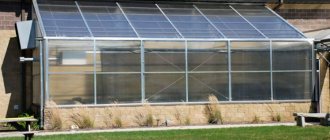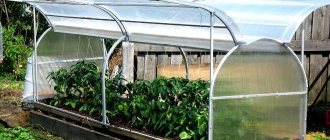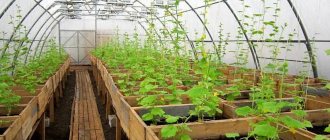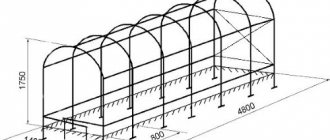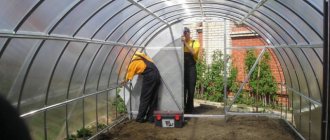In such greenhouses, exclusively environmentally friendly products are grown, since organic matter is used as fertilizer.
A solar bio vegetarian is a type of greenhouse, with its own design features. In such greenhouses, exclusively environmentally friendly products are grown, since organic matter, such as vermicompost, is used as fertilizer, and if pests appear, they are controlled exclusively by biological means.
Typically, summer residents, whose region suffers from late blight especially early and the growing season of tomatoes is difficult to prolong, begin to think about using a solar vegetarian instead of an ordinary greenhouse. Moreover, it is not at all difficult for a simple physics teacher to build this ingenious invention and architectural miracle, even if you do not read Soviet textbooks and do not hire professionals. How to build a solar bio vegetarian with your own hands?
Greenhouse Vegetarian: An Everyday Miracle with Extraordinary Potential
Growing vegetables in geogreenhouses is a progressive method of indoor farming. There are many reasons for this - 100% environmentally friendly technology, savings on energy resources, demand for natural agricultural products grown without chemicals.
We admire Dutch or Canadian farmers and their developments, forgetting that the effective vegetarian of our time - the solar house - was created back in Soviet times by an ordinary teacher who “tamed” the sun. For more than half a century, solar vegetarianism has been breaking the stereotypes of growing vegetable and fruit crops in ordinary greenhouses.
Thanks to his development, the author received more than 200 kg of lemons from a small area of 16.5 m² and up to 40 kg of vegetables from each meter of area. Moreover, the greenhouse operated without heating from February to November.
All the sunlight passes through the rounded transparent roof, warming up the vegetarian space inside as much as possible.
How the vegetarian is designed
A solar greenhouse consists of the following elements:
- The back wall is necessarily opaque and warm. You can attach a vegetarian garden to a bathhouse or home. If there are no buildings on the site, then it is better to erect an insulated rear wall with a height of at least 2.5 m: brick or slate, which should be whitewashed or painted in light colors, or a reflective sheet should be laid.
- The roof should be flat, pitched, with a slight slope to the south (permissible to the southeast). The material can be polycarbonate with a thickness of 8 mm or glass. The slope of the roof is determined by the terrain: if the solar greenhouse is built on a flat area, then the roof is located at an angle to the surface of the earth, but if on an inclined one (which is even better), then relative to the slope of the terrain.
- The ventilation system is made of metal pipes, PVC or HDPE at a depth of 0.3–0.35 m. Pipes Ø 50–110 mm are laid at intervals of 0.5–0.6 m from each other, the trench is filled with expanded clay.
- The ventilation system is also a heating system. But in severe frosts, you can use additional heating according to the scheme for simple greenhouses.
Design Features
Externally, this miracle greenhouse resembles an airplane wing: the aerodynamic shape of the structure, where the translucent part faces south, is the key difference between the vegetarian garden.
The aerodynamic shape of the vegetarian design allows for maximum use of solar energy
It is this that ensures the effective reception of solar energy, due to which:
- if the daytime outdoor temperature does not exceed -10 °C, then to collect vegetables, herbs and fruits in the vegetarian garden there is no need for additional heating (here +20 °C), and during night frosts, reaching -15 °C outside, the temperature inside the room is freezing the thermometer does not fall below +12 °C;
- frequent watering is not required;
- Due to the special method of air circulation, plants do not need ventilation. And additional ventilation in the vegetarian area will have a detrimental effect on the yield, since the necessary nitrogen, moisture and carbon dioxide are lost.
Types of vegetarians
There are many types of such unusual structures. They may vary:
- by design - whether the wall of a building is used as the back wall of the vegetarian garden or is it a separate building;
- on the building materials used;
- in terms of energy - the energy of the sun is used alone or simultaneously with the energy of vermicompost (hence the difference in terminology: SV - solar vegetarian and SBV - solar biovegetarian);
- by purpose (crop is grown for oneself and one’s loved ones or for trade);
The SBV DACHA-I project is used on personal plots with year-round residence and is intended for growing crops not only for your table, but also for sale
- by area;
- for the arrangement of air vents and heat accumulators.
When choosing one type or another, you need to take into account the size of the site, what the structure will be used for and your financial capabilities.
Any modification is easy to do yourself if you show a little ingenuity and adapt the model you like to your needs. For example, use plastic bottles when arranging ventilation and heating (each bottle is 50 W of stored thermal energy) or use the old technology of building walls from bags of earth.
Pros and cons of vegetarianism
The eco-complex has an undeniable advantage - the reasonable use of solar power. The solar flow falls on a sloping roof at a right angle and is almost not reflected from its surface.
All solar energy is used entirely for lighting and heating the greenhouse: in the warm season it is almost four times more than in a standard greenhouse, and in cold weather or at night - 18 times. This is a significant difference. That is why the vegetarian is called a solar house or a new generation greenhouse.
This organization of solar energy use provides many advantages:
- low energy consumption;
- increase in yield compared to conventional greenhouses by 5–10 times;
- the plants actually do not get sick. And if it is also a bio-vegetarian farm (BV), where vermicompost serves as fertilizer, then the products are of the highest quality at low cost;
- construction costs much less than the construction of Dutch greenhouses, famous throughout the world;
- easy operation and fairly quick payback (much faster than the same Dutch devices).
During the entire period of creation, no disadvantages were identified, provided that the vegetarian garden was built correctly. Although on forums where greenhouses are discussed, there are both supporters and opponents of such a device. Those who are against it complain about overheating in warm weather and the need for additional insulation in severe frosts.
You can save yourself from overheating with canopies made of non-woven materials or nets. They will reduce the flow of sunlight. As for additional insulation, it is required where the vegetarian is covered with film instead of glass or polycarbonate. And the extent to which the technology of construction by opponents of vegetarianism has been maintained remains questionable.
Video: vegetarianism in winter - what made me happy and sad
Even the fact that the Chinese, who are ahead of the rest in all sorts of progressive innovations, picked up this technique, modernized it to suit their conditions and now grow good crops even in areas where frosts reach -40 °C speaks in favor of SV.
Photo gallery: amazing sunny house
Only part of the back wall is attached to the building: the vegetarian garden and the house are made in the same exterior and harmoniously complement each other
A vegetarian garden built according to all the rules - the back wall is completely adjacent to the house, a single-pitched sloping roof, the plot is located with a slope to the south
The unusual autonomous design is assembled using the “thermal fortress” technology, which allows efficient use of solar energy, and the dome-shaped shape makes the vegetarian garden a decoration of the site
Inside there is an ideal microclimate for growing plants all year round, and if you also create exhibitions, you can attract tourists
All plants without exception can be planted in a vegetarian garden, taking into account the purpose of cultivation
Reviews
I want to share my experience about solar vegetarianism.
Today the temperature outside reached 20 degrees, in the vegetable garden above the ceiling with the transoms open it was below 40, at ground level 34, and the tomatoes seem to be doing well. From the moment of germination (March 1) until today, their height reaches 50 cm. From last year’s experience, the taller the plants, the lower the temperature in the vegetarian area. Apparently, this is due to the fact that the soil and paths warm up less + due to the height of the sun, the sun's rays are reflected more from the vegetation, therefore, less of them penetrates inside. And the internal heating of the soil due to the pipes is an excellent growth stimulator + humidity, which means they won’t have to burn even at 40. Gerasim
https://dacha.wcb.ru/lofiversion/index.php?t19374.html
I create a vegetarian garden at the dacha primarily for the soul, and to grow exotic plants there!
Well, I just like it! And just to make money, you don’t need a lot of intelligence. It is enough, for example, to create an apiary in the country! Bees fly - they carry honey - money from the sky! For a simple calculation, each hive provides an income of at least a thousand hryvnia. If you want, for example, twenty thousand, put twenty hives, if you want one hundred thousand, put one hundred hives, and so on. There is NO NEED to look for a sales market - this highly liquid product can always be sold in bulk and you don’t even need to transport it anywhere - they came, took it, and counted the money. You just need to pump it out and cook it. vladumur58
https://www.aquafanat.com.ua/forum/index.php?showtopic=57128&st=40
Enough articles have been written about coverings for greenhouses, which describe the pros, cons, technical characteristics, etc.
Without getting involved or describing this topic in detail, I come to the conclusion that the best option for covering a vegetarian container is glass, and the ideal option is quartz glass. In modern conditions, this is a double-glazed window. All types of plastics are inferior to glass in all respects except price at the time of purchase. Glass has the best transparency coefficient, i.e. the property of transmitting the amount of light. Some authors write that plastics are almost as good as glass in this regard. Perhaps, but we must not forget that all plastics are quickly scratched, and at the same time the translucency decreases. The ice crystals that make up the snow will scratch the coating in one season. Any attempt to clean or wash the coating will also lead to damage. Cellular polycarbonate has an additional negative property - it is the gradual contamination of the honeycombs; condensation often appears in them. Condensation itself is an obstacle to light, in addition, because of it, dust is retained inside the honeycombs faster, which will also lead to a decrease in light transmission. The next factor is the range of transparency, i.e. the property of the material to transmit different types of spectrum from the ultraviolet zone to the infrared. The range of transparency is important both for the plant itself and for the formation of the microclimate. For example, ultraviolet is important for plant growth, and infrared is important for heating the room. In my opinion, quartz glass has the best range of transparency. The only difficulty is the price of the issue, in addition, the weight of the glass is greater than that of other materials, but remembering that the most important thing for us is the conditions for the plants, and the fact that the vegetarian garden is a permanent structure, the choice is a clear double-glazed window, preferably made of quartz glass. To partially reduce the cost of coating, you can alternate glass - plain, quartz, plain, quartz, etc. skazochnik
https://forum.anastasia.ru/topic_58711.html
Installation of a heating system for beds, vents and doors
Now you can make and install a door, build a shelf for barrels of water and other little things.
You also need to carefully consider the irrigation and ventilation system. Water in barrels left overnight will be an excellent heat accumulator for a vegetarian. The water will accumulate heat all day, which will be released at night. Thanks to this, temperature jumps between times of day will be significantly smoothed out. Of course, such water will not be able to warm, so a more serious system is needed.
The heart of solar bio vegetarianism is a closed cycle of heat and air exchange. For these purposes, it is necessary to lay pipes in the soil to a depth of 50 cm, between which there should be a distance of 60 cm. The upper ends of the pipes should be brought under the roof, and the lower ends should be brought above the ground. It is necessary to install exhaust fans on the pipes themselves, which will operate around the clock. With their help, the air in the soil will be cooled during the day, and at night heated from the earth, which has collected heat during the day, and enters the vegetarian garden. Therefore, such a system can save plants from destructive overheating in extreme heat and warm them on cold nights. Thanks to this, the roots of the plants are constantly in favorable conditions, and all carbon dioxide and moisture are retained in the vegetation. In addition, there is no need to water the plants frequently, since the leaves evaporate water weakly and the humidity almost always remains at a high level, which helps to increase the size of the fruit.
A striking example of the work of a vegetarian is the successful experiment of the creator of the vegetarian, who was able to collect 216 kg of lemons from two eight-year-old plants on 17 square meters. According to calculations, the production in a vegetarian garden is three times greater than in a conventional greenhouse, and the cost of fruit is also reduced by three times. The scientist Temiryazev also said that fertility has a limit, which is determined not by the amount of watering and fertilizers, but by light energy. It is for this reason that solar vegetarianism is a real solar technology.
In bio vegetarian plants, plants bear fruit almost a month earlier and at the same time do not differ at all in the content of microelements or in taste from vegetables grown in the open air. This is a real miracle of technology!
Preparation for construction
Remember two main rules - the presence of a slope of 5–40° in the north→south direction (it is on this slope that the vegetable garden will be planted) and that we make the back wall solid and reflective. This is the secret of vegetarianism.
If the slope is natural - very good, if not (or the slope is directed in the other direction), then you will have to make it artificially.
The penetration of the sun's rays will be fully exploited if the vegetable garden is sloped from north to south
Preparing the site
Such work does not require large material costs and is completely doable in a couple of days alone. To begin with, we draw a sketch of the future vegetarian garden and determine the size of the building site. It all depends on the size of the plot and for what purpose the vegetarian garden is needed.
We create a detailed diagram of a solar vegetarian garden: with the breakdown of ridges, the arrangement of a ventilation system, drip irrigation and racks of logs
To provide food for the family and please relatives, vegetarians of 24–64 m² are built, so in this case an excavator is not needed. A slope is formed by adding earth or clay and is periodically thoroughly compacted. And so add to the desired height. There is no need to compact the top layer.
When starting backfilling, first remove the fertile layer of soil throughout the entire site, which will later become the top layer.
Before adding, it is necessary to remove the fertile layer of soil in order to lay it out later on the beds, and not to buy additional black soil
Sometimes the size of the plot does not allow the construction of a large vegetarian garden for business. In this case, place 2-3 smaller ones next to each other.
Selecting material: tips
For construction you will need:
- for laying the foundation - corrugated reinforcement and annealed wire for tying it, concrete grade 200–250, roofing felt, chrysotile cement pipes Ø 120–150 mm and scraps of plastic pipes Ø 50–110 mm;
- for formwork - moisture-resistant plywood (panel) and boards;
- for the frame - wood or metal pipes of rectangular cross-section (metal is preferable, since it is not subject to rotting), hammer enamel and galvanization for the manufacture of ebbs;
- for assembling a ventilation system and heating the soil - PVC or HDPE pipes with perforations at the bottom to prevent moisture from escaping, fans, couplings, crosses, bends, adapters, an electric or gas heat gun (for additional heating in areas with severe climatic conditions);
- for the construction of beds and drip irrigation - a water pipe Ø 20 mm, valves and taps, paving slabs or its substitute for sealing passages, a board with a cross-section of 25 mm for boxes and cutting timber, large metal or plastic barrels (heat accumulators) to maintain a constant temperature;
- for covering the roof and walls - cellular polycarbonate or glass (for walls, polycarbonate up to 4 mm thick is suitable, for roofing - from 8 mm and above);
- for wooden frames and frame cladding - antiseptic, paint for wooden surfaces or textured universal coating, silicone sealant, dry timber, bolts with nuts and washers, connecting profile and end profile, self-tapping screws with thermal washers.
The straight slope of the roof of the vegetable garden does not allow large amounts of snow to settle
When constructing a vegetarian garden, you must initially provide a method for clearing snow from the roof. For this, stiffening ribs are needed so that they can subsequently move freely on the roof without damaging the polycarbonate.
Some people recommend using asbestos-cement pipes instead of chrysotile-cement pipes. We strongly do not recommend doing this. Although pipes of the same class and asbestos-cement are cheaper, amphibole asbestos is nevertheless poisonous and can cause serious diseases. Chrysotile is much safer in this regard. So it's not worth the risk.
The amount of material depends on the size of the vegetarian container and its design. You need to calculate everything in advance according to the sketch. This will make it possible to determine not only the volumes, but also the replacement of this or that material.
Tools
When building a large eco-greenhouse for business, you cannot do without an excavator. And so basically you will need:
- jigsaw;
- shovel;
- welding machine (if a metal frame is being made);
- screwdriver;
- grinder for stone and metal;
- tape measure and twine;
- construction level and drill.
Construction of the frame
You can make Ivanov’s solar vegetarian with your own hands from various materials. As construction experience shows, both especially durable metal and inexpensive structures cope well with all functions. Only the tree does not always feel good in this ecosystem, since the humidity level inside the greenhouse is much higher than in a simple greenhouse. The ideal option for building a vegetarian garden is a profiled pipe with dimensions of 40x40 cm and 20x20 cm. To build the frame, you will need the following tools: an angle grinder, a metal saw and a screwdriver.
When constructing a solar vegetarian yourself, a frame of two parts (4 and 6 meters) is simpler and easier to cook on the ground. And after that it can be tied to poles and connected. In the same way, you can construct a rafter system, which can then be lifted and installed one piece at a time.
After the entire frame is welded, it will need to be protected from rust with special paint, since there is always high humidity inside the vegetable garden.
Vegetarian finishing
Vegetarian decoration is, in principle, optional, so it is used only for decoration. It is good to cover the back wall with decorative panels. To do this, you can use pixel panels, which will make the room ventilated, insulated and enhance the effect of the thermos.
But this is just advice. Some will prefer colored facade plaster, others - wild stone. The main thing is that the vegetarian garden is combined with the exterior of the house and fits harmoniously into the landscape design of the garden plot.
How does a solar greenhouse work?
DIY polycarbonate greenhouse, drawings and instructions
Solar vegetarianism is exactly the case when science finds the most practical way to solve pressing problems. The laws of incidence and reflection of light, the trajectories of air masses, and the thermal conductivity of various materials are taken into account here. There are several principles according to which a solar greenhouse produces 30% more products with less energy consumption:
- Sunlight in temperate latitudes hits the Earth at an angle. The horizontal roof of traditional greenhouses reflects a significant part of it. The sloping roof and the rays of light form a right angle, which means the air inside warms up earlier and better.
- Ivanov rightly believed that ventilation of greenhouses leads to a deterioration in air quality for plants. And in fact: oxygen, for which a person ventilates both his lungs and his rooms, is produced by plants themselves during photosynthesis. But carbon dioxide, necessary for this very photosynthesis, evaporates into the atmosphere during ventilation. And humidity, to which tropical crops, such as cucumbers, are so sensitive, drops noticeably. Therefore, the air in the solar greenhouse is mixed using a system of perforated pipes and a powerful fan.
- Heating of the vegetarian room is carried out according to the principle of a heat exchanger. Air warmed by the sun is pumped into pipes laid in the soil and transfers heat to the beds. At night, the earth, in turn, shares its accumulated heat with the air.
- As the heated air enters the cool pipes, the moisture in them condenses and enters the soil through the holes - this is why the pipes are perforated. In fact, it turns out to be drip irrigation.
The principle of heat exchange in vegetarianism
Nuances of operation
The main task of a vegetarian garden is to create and maintain a certain microclimate in it. This is why the slope is made. But you can achieve heat preservation in another way - instead of a slope, dig a pit below the freezing point. It is best to make the back wall concrete and be sure to cover it from the inside with foil or other reflective material, and veneer the outside. Be sure to periodically clean the polycarbonate coating and cover the vegetarian with heat-insulating materials at very low temperatures.
Distinctive features
Ivanov’s vegetarian garden is being built in a certain part of the site - on the south side or southwest, southeast
This is an important condition, which at first glance cannot always be met. It only seems so
One of the walls of the greenhouse, the northern one, must necessarily be brick or concrete. And a vegetarian will fit in a small area if you combine it with the wall of the house. This will not be considered an error; the microclimate inside the greenhouse will remain stable.
The roof should be flat, pitched, and sloped for ease of snow removal in winter and optimal distribution of sunlight. The tilt angle should be from 15 to 40 degrees. The design will be unusual and beautiful. The aesthetics of the site will be enriched.
The material used is cellular polycarbonate or classic glass. For the roof you need sheets with greater thickness. The building is capital. You need to build a frame - metal or wood. The foundation is being created. The cost of constructing a standard greenhouse made of cellular polycarbonate may be slightly lower in the end; it is easier to work with this material. How long will the structure withstand the load of wind, rain, snow - that is the question. The difference in the estimate is small, if you look at it, take into account indicators of reliability and durability. It will be easier to grow vegetables, fruits, and herbs in Ivanov’s greenhouse.
ATTENTION: The brick wall is covered with foil insulation, which reflects the sun's rays during the day, guarantees warming of the soil, and takes care of the plants. The wall itself gets hotter
In the dark, it releases heat gradually, warming the air. A strong ecosystem and favorable environment are created thanks to these features.
Video: do-it-yourself solar vegetarian in the Krasnodar region
It’s easy to become the owner of this solar miracle: build it yourself by studying the technology of construction and internal structure. Taking into account all the nuances of operation, you can freely grow exotic fruits, berries, vegetables, herbs in a vegetarian garden and harvest 2-3 times a year.
- Author: Valentina Trubich
Not ideal, but real))) Rate the article:
- 5
- 4
- 3
- 2
- 1
(31 votes, average: 3.2 out of 5)
Share with your friends!
Polycarbonate frame coating
Relying on extensive experience in constructing vegetarian sheds, we can confidently say that the best material for covering it is cellular polycarbonate. Polycarbonate sheets with a thickness of 6 mm are ideal for the roof, and 4 mm for the walls.
To ensure that there are no drafts in the greenhouse, it is necessary to seal the place where the polycarbonate adjoins the wall with pipe insulation under the ridges inside the greenhouse.
Dimensions and design drawings
Step-by-step instructions for building a bio-type greenhouse with your own hands begin with choosing a drawing and dimensions of the building. The floor plan can be found on the Internet or ordered from a design company, but the dimensions will need to be thought out in advance. They depend on your financial capabilities, size of area and requirements. Typically, the room size is 4 m wide and 6 m long. Height - according to your height.
The main thing that needs to be taken into account during construction is the level of inclination of the floor and ceiling. To ensure adequate lighting, the beds are built in a cascade, for which the floor level should be located at an angle of 30–35°. The ceiling should be parallel to the floor.
As already mentioned, the rear northern wall should be solid and covered with insulation and reflective material. The best option would be to attach the building to the wall of the house.
Answers to the main questions
Is Ivanov's vegetarian garden the most efficient greenhouse?
As you have already seen for yourself, Alexander Vasilyevich’s development has clear advantages over conventional greenhouses. And even if you build a vegetarian garden according to Ivanov’s principles, without using modern technologies, it will definitely give excellent results - the harvest will be earlier, costs will be lower, and the growing season will be longer. That is, with the right approach, such a building will pay for itself and will delight you with excellent harvests. The most important advantage of vegetarianism is its ability to use the sun's energy as efficiently as possible.
But there is no limit to perfection. Today in Europe there are efficient solar greenhouses that combine all possible achievements in this area. True, a lot of money is spent on their construction, which is not always affordable for the average person. In the CIS, work is also underway in this direction - people are excited about this idea and are trying to improve the technology even more.
Why has the idea of solar vegetarianism not been widely implemented?
Answering this question is not at all difficult.
- Making a regular greenhouse is much easier and faster.
- Not everyone is ready to spend time and money on building a vegetarian garden.
- Not everyone knows how to build with their own hands.
- This idea cannot be realized on any site (you need a southern/south-eastern slope or, at a minimum, a place for its artificial arrangement).
- On an industrial scale, it can be easier to buy ready-made technology with automation and greenhouse design.
These simple factors are the reason why Ivanov’s vegetarian diet is not widely used. But this does not mean that the situation will never change. You may want to fix everything and, at a minimum, build a solar greenhouse on your site. And then, having received amazing results, inspire other people. This idea is definitely worth implementing!




